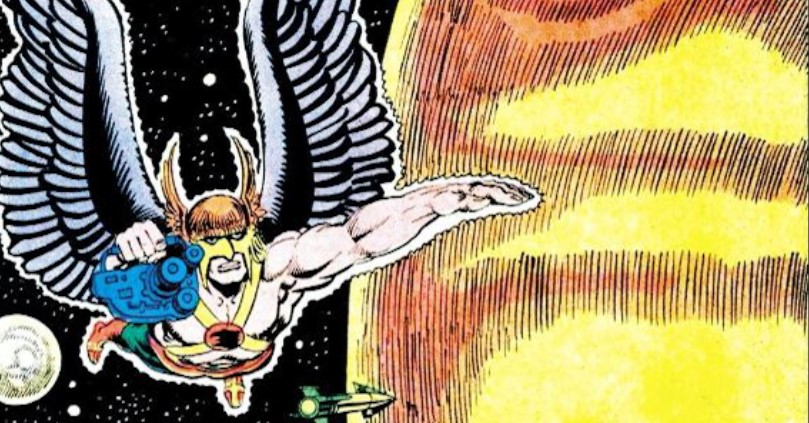If you’ve been around here for a while, or even if this is your first stop, it’s pretty obvious – we’re all about blending pop culture and science.
Hawkman and Hawkwoman (the Katar and Shayera Hol versions from Thanagar) have always had science fiction in their DNA. They come from the science-based planet Thanagar (which has had orbital problems as the result of attacks) which orbits Polaris, they’re able to fly due to the properties of Nth metal, one of the fantastic elements of the DC Universe – which played a major role in DC’s Dark Knights: Metal event in 2017-18, and as was also revealed in that event, the true home of the Thanagarians, Thanagar-Prime, exists outside of the home dimension of the DC Universe and contains all of the collected knowledge of the universe.
Science fiction.
Of course, if you’re more familiar with the fantasy side of the Hawks, from say, CW’s DC’s Legends of Tomorrow or their more recent appearance in comics, there’s a lot of mysticism baked in as well – reincarnation, loves lost to time, Vandal Savage, timelines woven in throughout the history of the DCU, Egyptian gods, and magical monsters. Let’s not go with that. Let’s stick to science.
And fiction.
Hawks in Spaaaace!
So with the Hawks, let’s turn the clock back…forty-one years, back to World’s Finest Comics #258, published in July of 1979, and the story “Death Orbit” by Gerry Conway, Rich Buckler and Romeo Tanghal for a throwback Scienceish Lesson, and see how much science we can wring out of this short tale.
Conway’s story is steeped in space science and special relativity, fitting for a visitor from a far-distant star system. Let’s hit the high points…
Opening with a panel showing Hawkman flying near Jupiter, there’s a brief (and very accurate) mention of Jupiter and our solar system: “It’s been said that our solar system is composed of the planet Jupiter and a few chunks of dust, for such is the sheer size of that incredible planet that every world orbiting the sun seems like a petty afterthought by the great creator…”
That’s pretty much spot-on true. In terms of the mass of the solar system, obviously the sun has the most, and it’s not even close: 1.9884 x 10^30 kg, while Jupiter checks in at 1.898 x 10^27 kg. Put another way, Jupiter has 2.5 times the mass of all the other planets in the solar system, combined. Due to its huge mass, the barycenter of the Jupiter-sun system – the center of mass of two orbiting bodies, or the point around which the two bodies orbit – is a little over the radius of the sun from the sun’s surface.
Jupiter’s gigantic mass means that it has an effect on everything in the solar system, including all the other planets and moons, and even satellites. Take Jupiter out of the solar system, and it wouldn’t behave the same. Add some more mass to Jupiter – about 50 more Jupiter’s worth, and that may be enough to cause it to ignite and become a brown dwarf. Add about 75 Jupiter’s worth, and it would ignite, fusing hydrogen into helium and become our solar system’s second star.
It’s big.
Jupiter’s Storm
The story starts with Hawkman investigating Jupiter’s Red Spot – that’s it. He’s just straight-up, legit doing science. He’s curious. He’s wanted to know what’s up with Jupiter’s Red Spot since he arrived in our solar system. More than that, he name-checks [William Rutter] Dawes, who “discovered” it in 1857.
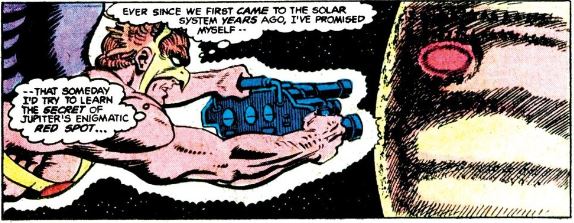
Hawkman checking out Jupiter’s Red Spot, and dropping some science facts (c) DC Comics
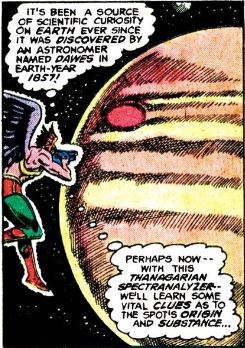
You can read a million comics, and this is most likely the only one you’ll find that gives a shout out to Dawes. (c) DC Comics
“Discovered” gets quotation marks thrown around it, as observers have noticed a spot on Jupiter for centuries. Given that the spot is a dynamic atmospheric storm, there’s a question as to whether the early observations of Jupiter’s spot are talking about the same spot that was definitively and continuously seen since the late 1800s. A British cleric and astronomer, Dawes observed and drew the spot on Jupiter, noting that it was, in fact, red.
The spot is located in Jupiter’s Southern Hemisphere as we view the planet, which means that, as shown in the opening page of the story, Hawkman and the action shown around Jupiter would have been upside down, relative to observers on earth. If Hawkman would’ve looked back at the earth from that position, he would’ve seen Antarctica at the “top” of the planet and the “North Pole” at the “bottom.” No big deal, though – there is no up in space. Just an interesting sidebar to note – the whole story was basically, upside-down.
The cool part about this is that Conway wrote this story in 1979. This was right when the Voyager spacecraft were giving us our best looks we’d ever had of Jupiter and its turbulent spot. Voyager 1 was watching Jupiter from January through April of 1979, started observations in late April, and continued looking at the planet through August. The images were fantastic – the best images of Jupiter that humans had ever seen. As a country, we were transfixed. Science classes in schools showed them, magazines and newspapers reprinted the images. Oh, and this was just a couple of years after Star Wars and the other space stories it spawned. Space was on everyone’s mind, and here is our own space neighborhood. Apparently, Conway was one of the folks whose interest was piqued as well.
In the 41 years since this story was published, Hawkman would be impressed by what we’ve learned about the Red Spot of Jupiter. The Red Spot has changed size over the years – and perhaps has even dissipated and re-formed since the Italian astronomer Giovanni Cassini first pointed his telescope at Jupiter in the 1600s and spotted it. Currently at less than 20,000 km wide, the Great Red Spot is less than half as big as it was just 100 years ago, so the thinking goes that the Great Red Spot could be a repeating phenomenon of Jupiter’s atmosphere, forming and dispersing over and over again. In short, we haven’t been watching the Red Spot long enough to determine if there’s a pattern to its shape over time. The Great Red Spot that’s currently on Jupiter is the one that we’ve been observing for nearly 200 years, but it can’t be said with any certainty if it’s the same one Cassini saw in the 17th century.
And the Red Spot is a giant storm – one of many on the planet. The Great Red Spot is the largest and fiercest storm on Jupiter, with winds on its edges hitting speeds of around 400 miles per hour, while winds inside the storm appear to be much slower and even, at times, barely moving. Presumably driven by Jupiter’s internal heat, the Great Red Spot spins in a counter-clockwise direction, making a full rotation every six earth days. Its boundaries are defined by two jet streams in Jupiter’s atmosphere that make the Great Red Spot remarkably stable in its north-south position on the planet, at 22° south of the equator. But the Great Red Spot is free to move east-west and has circled the planet at least 10 times since the early 1800s. The latest addition to Jupiter’s collection of storms was just spotted recently and officially named in July: Clyde’s Spot.
So back to the story…
Space Invader
As the story continues, Katar gets called back to the ship due to an unidentified vessel entering the solar system about three Astronomical Units out from Jupiter (and the definition of “AU” is given), traveling at 0.89 the speed of light – 160,200 miles per second (2.58 x 10^5 km/s). The ship will pass Jupiter in 30 minutes, and then it will go on to hit earth. As Shayera notes – due to its speed, its mass is approaching infinity (more on that in a second).
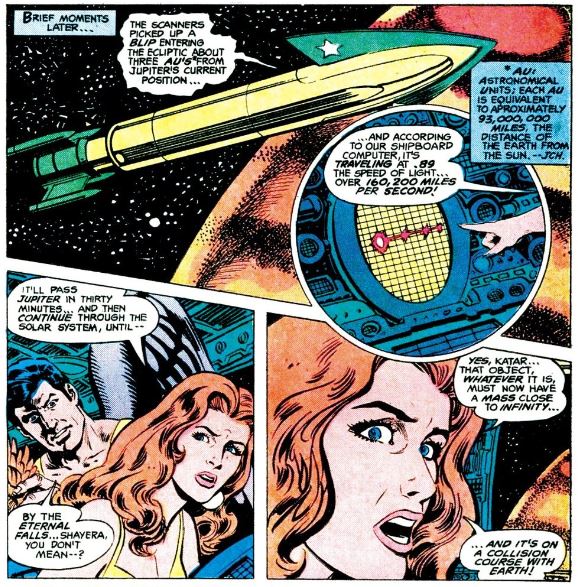
It’s an emergency – with physics too! (c) DC Comics
The Hawks head off to intercept the ship – according to one of them (the speaker is unidentified in the panel, but I like to think it’s Shayera) it’s going to take them nine minutes to accelerate to near-light speed and under twenty total minutes to match the speed of the invading ship – and that’s without using hyper-drive, which must take them out of conventional spacetime.
Let’s unpack that a little…if you’ve had a physics class, you may be starting to get that prickly sweat. It’s just a variation on the old chase problem from physics. One-dimensional kinematics. That’s it.
Basically, for simplicity’s sake, let’s think of it this way – the Hawks are the cops sitting behind a billboard. They get word a speeder is coming their way, moving at a constant speed – or maybe think of a galactic CHiPs team getting word of a runaway truck. They need to catch up and pull their speeder over, figuratively speaking – or just convince them to change their course and not hit the earth, please.
What makes this one difficult is that we don’t know the Hawks’ acceleration which will allow them to catch the invading ship. And the claim that they have ”less than twenty minutes to match speed with the intra-solar invader…nine minutes to reach near-light speed without using our hyper-drive…”
Yeah, that just makes things a little confusing.
If the invading ship was 3 AU out from Jupiter and on an imminent collision course with earth, then figuring out how long the Hawk’s have until the earth is destroyed is easy:
Speed = distance/time….so, rearranging:
Time = distance/speed
The distance is 3 AU (151.84 million km) plus the average distance between Jupiter and the earth (778 million km) is roughly 1.23 billion km. That’s a lot of space, but the intra-solar invader is moving fast. How long do they have before impact?
Time = (1.23 x 10^9 km)/(2.58 x 10^5 km/s)
Time = 43,527 seconds, or 725 minutes, or about 12 hours.
Mind you, that is until impact. A ship moving this fast, with near-infinite mass will take some time to turn, which is why the Hawks are all worried about less than 20 minutes…I guess? I prefer to read that as they wanted to get to the invader as soon as possible, which would allow for as much time to confront whoever was driving that rig – so, maxxing out their ship, they’d get there in less than twenty minutes.
Also – this is all happening near the speed of light, which are called relativistic speeds, which explains Shayera’s observation that the invading ship’s mass is near-infinite…which isn’t exactly true. By now, it’s a dated concept, and still a very common mistake – the idea that as something moves faster and faster, its mass increases until at the speed of light, an object would have infinite mass. But that’s not how things work at relativistic velocities. Relativists view mass as unchanging. It doesn’t increase with increasing speed.
Let’s let Don Lincoln from Fermilab explain a little more:
So, the mass of the “intra-solar invader” ship? It’s just a mass. We see later that it’s the size of a moon, so it’s probably a pretty large mass, but still, “large” =/= infinite. But that’s a common faux pas in physics, even, so I’m going to give Conway and Shayera a pass.
Speeding Up to Catch the Invader
Going back and talking about catching up to the invader ship – the Hawks’ ship would have some initial velocity, as it would have been orbiting Jupiter, rather than sitting over Jupiter. Sitting over a planet is a way to find out what it will look like when your ship impacts the planet. To stay above the planet, you need to be in an orbit, which means you need to be moving around the planet at a velocity that’s related to your mass and distance from the planet’s center of mass.
The problem for us trying to insert science into this is that we don’t know the initial velocity of the Hawks’ ship. As such, we can’t figure out the acceleration with our classic acceleration formula:
Acceleration = (final velocity – initial velocity)/time
We know the final velocity – the speed of the invading ship. We know the time – let’s say 19 minutes as the soonest the Hawks can intercept the ship traveling at the outer limits of their ships’ abilities, but we don’t know the acceleration. Our formula has two unknowns. Bummer.
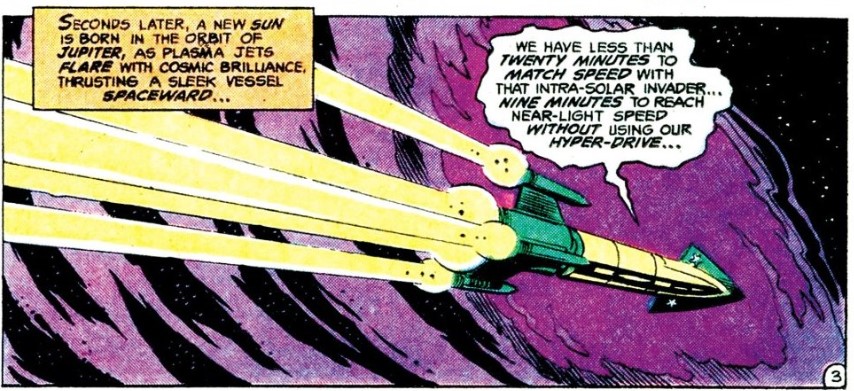
I don’t read comics for 100% spot-on representations of relativistic travel, and neither should you. (c) DC Comics
Given that they’re speeding up from a velocity similar to one of Jupiter’s moons (Europa goes around Jupiter at about 13.7 km/s) to 2.58 x 10^5 km/s in about 20 minutes, the acceleration is pure comic book science – just putting those numbers (changed to m/s) in gets you a value of
Acceleration = (2.58 x 10^8 m/s – 13.7 x 10^3 m/s)/1140 seconds
Acceleration = 1.84 x 10^5 m/s/s, or 184,275 m/s/s
To put it in more familiar (YMMV) terms, that’s 18,804 G
As the panel shows, Katar notes this:

Those are some good dampers. (c) DC Comics
At this point, I have to throw the fictional flag and claim the ship has the Thanagarian version of the Star Trek physics inertial dampeners made of nth metal…something that will magically reduce the effects of acceleration on the passengers inside a spaceship so they won’t get smashed against walls as the ship turns, or turned into a paste as their speed increases by a factor of more than 10,000 in this case. The strain that Katar and Shayera are feeling? They’re just going faster than the Thanagarian inertial dampers can handle.
An Edwin Hubble Shoutout!
As they’re accelerating, the Hawks prove their love of science once again, marveling at how different space looks when you’re traveling near the speed of light. Seriously – real estate on the pages of the story is given so Shayera and Katar can discuss redshift and blueshift as a consequence of their speed.
Katar’s description of redshift and blueshift is a touch open to interpretation, and he might be feeling a little off due to the massive G forces he’s under, but he’s in the right ballpark-ish, concept-wise. As the Hawks travel, the stars they’re moving towards would appear blue, because their speed is acting to compress the wavelengths of light coming towards the ship as they observe them – blue/violet light has the shortest wavelengths in the visible spectrum. On the flip side, the light from the stars behind them would be reddish, as their motion is acting to stretch out the wavelengths of light, making them appear longer. Red is the color of light in the visible spectrum with the longest wavelength.
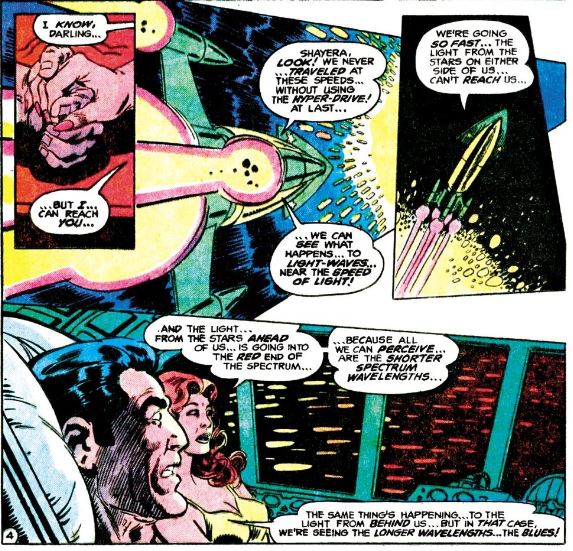
When traveling at relativistic speeds, take time to look out the window, will ya? (c) DC Comics
This is the Doppler Effect – the same thing that you experience when, say, an ambulance drives by you with its siren on. The siren has a high pitch as it’s coming toward you – the speed of the ambulance adds to the speed of the sound and compresses the sound waves, increasing their frequency. Higher frequency (more waves per second) = higher pitch. After the ambulance passes you, the siren’s pitch drops – the sound waves are stretching out relative to your position…longer wavelength = lower pitch.
What works for sounds on the street works for stars in the sky as well. The understanding of the Doppler Effect was crucial in the work of Edwin Hubble, who used it to show that most of the stars and other objects in the night sky are redshifted, that is, nearly everything is moving away from us. Extrapolate from that, and this thing that the Hawks notice, the same thing that you notice when an ambulance passes, explains why we know that the universe is expanding.
It also explains why there’s a telescope orbiting earth named “Hubble” too.
Finally intercepting the ship, Katar notes that it will hit the earth in 40 minutes unless he can divert it. Boarding the invading ship is no problem, as Katar himself notes: “Now that we’ve matched velocity with the rogue, our relative speed with regard to each other is zero, so I can fly to the ship.” Top marks – that’s 100% spot-on physics there. It’s the same reason why you can toss a ball up and down (as long as you’re not driving) while you’re in a car going 65 mph. The difference between the ball’s velocity and your velocity is zero. To someone outside – you and the ball are both moving at 65 mph. Inside that car though – it’s all normal. Nothing is moving faster than anything else.
Stop! Hawkman Time!
One more thing about the Hawks moving at the same speed as the invading ship – about 90% the speed of light – this goes back to an earlier post about time not being absolute. In the story, once they catch up with the ship, Katar notes that he has about 40 minutes until it hits the earth. That’s a bad thing. Like us, the Hawks like the earth and want it to stick around for a while.
But – one more heavy-duty physics idea here…because at this point everyone is moving at 0.89 the speed of light, the Hawks’ time doesn’t equal our time. Time dilation would play a role to an observer. Not the Hawks, mind you – an observer. Hawkman says he has 40 minutes. If he set a stopwatch, it would count out just about 40 minutes until the end of the story. But – if somehow an observer on earth saw Hawkman enter the invading whip – from that moment he had about 40 minutes left – it would actually take about 92 minutes for the ship to reach earth (and hopefully veer off at the last moment). The faster you move, the slower time goes, compared to an observer outside of your frame of reference (that person on earth).
This bit doesn’t affect light itself, actually…light’s speed is always constant, and the smallest pieces of light – photons – don’t experience time as we think of it. Probably best not to think about that too much right now.
Oh, and 40 minutes until hitting earth? How far away were the ships when Katar boarded? That’s easy:
Speed = distance/time
Distance = speed x time
Distance = (2.58 x 10^8 m/s)(2400 sec)
Distance = 6.19 x 10^11 meters, or 6.19 x 10^8 km from earth
619 million km from earth – that’s about the distance between earth and Jupiter at their closest point (they were just there on July 14th). All that catching up and crushing acceleration? Following the story’s setup (which diverges from the 12 hours calculated earlier) – that allowed the Hawks to meet the ship at Jupiter while traveling at the same speed. Their flight plan wasn’t a straight-line intercept, apparently. Best guess, they swung out on an arc to build speed, and then pulled in alongside the invading ship on its course towards earth.
Ponch and Jon would’ve done the same thing. This was just CHiPs in space.
On the ship, Hawkman notes that the atmosphere is mostly methane and ammonia, and the artificial gravity is such that he’d be crushed if it wasn’t for the gravity-canceling powers of nth metal. This is a nice nod to combat the trope that the vast majority of ships are for some reason, set at earth-like conditions. Not sure if Conway was giving a nod to some ideas of ancient astronauts, as a methane and ammonia atmosphere is evocative of the atmosphere of earth millions and millions of years ago. Perhaps this alien was coming by earth for a second look…
From there, things get a little ancient-astronaut-y and a touch tropey as Katar argues with a computer and then revives the long-sleeping inhabitant of the ship (a giant elephant with wings for ears who would’ve been at home on the side of a van in the ‘70s) that gives a warning about letting machines take over too much of life. The elephant thing takes control, and the ship corrects its course, missing the earth.
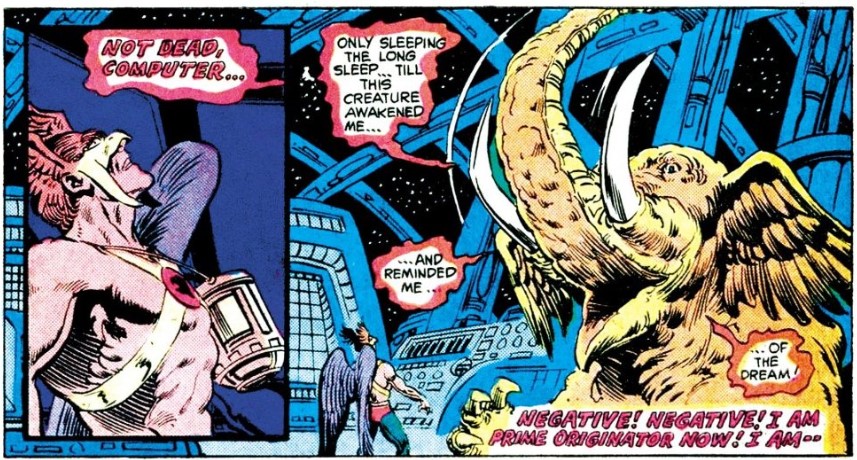
And then it went all 1970s van airbrush painting (c) DC Comics
Opening the possibility that he may have breathed in some methane and ammonia onboard the other tship, Katar gives a full on stoner thought at the end as well when asked about where the ship came from and where it’s going to: “Aren’t they all making the same journey we all make? The journey through life to the long sleep beyond…”
Yeah – heavy, man. Heavy.
But thanks for the science, Gerry.
A personal note – I bought this comic when I was 11 years old. To this day, I remember this story – it blew my mind. Here was a superhero who was interested in science, and in part, used his powers to learn more. And what did he learn about – Jupiter! Traveling nearly as fast as light! Meeting elephants with wings for ears…okay, maybe not so much on that last one, but this was that thing that hooked me, both on comics and science. I was in it for life. So yeah – thanks Gerry.


